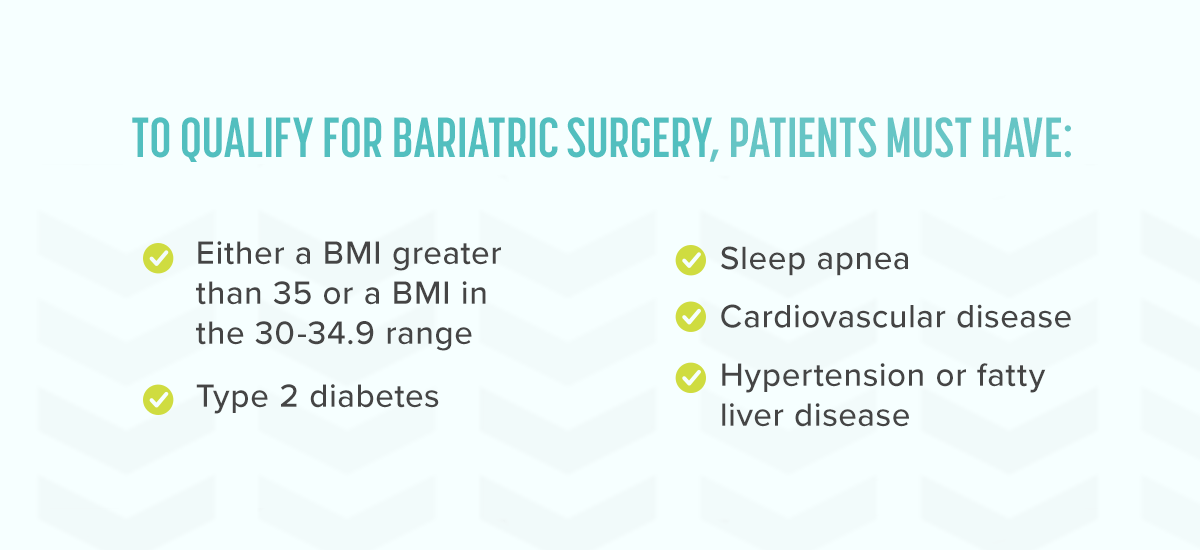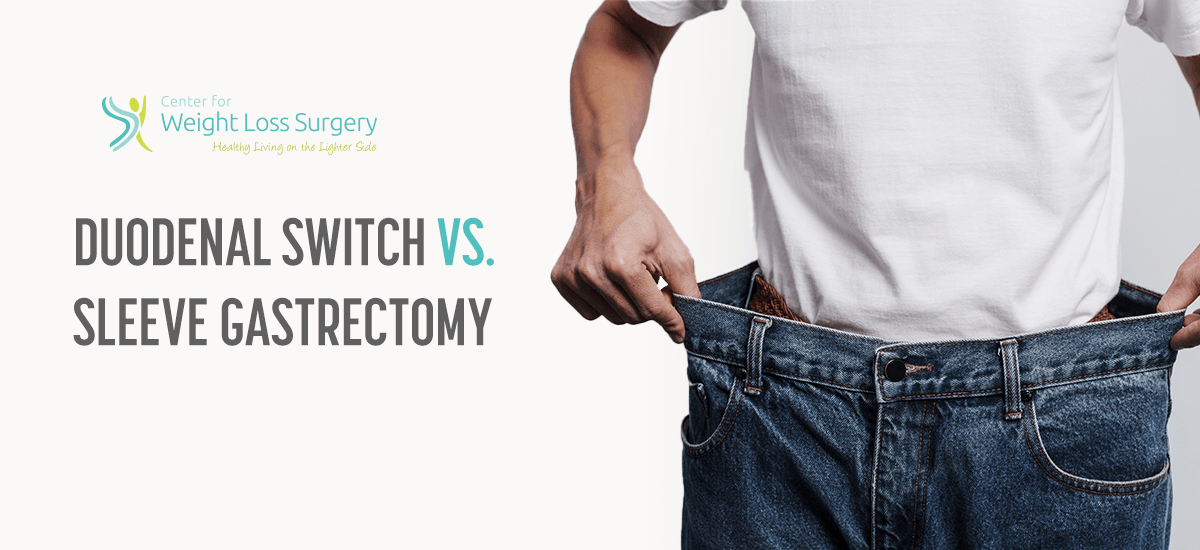Bariatric surgery is currently the most effective, evidence-based treatment for controlling obesity. It is the best treatment option for patients who do not achieve substantial or durable weight loss or co-morbidity improvement with nonsurgical methods.
There are two types of weight loss surgeries to consider — duodenal switch (DS) and gastric sleeve, or vertical sleeve gastrectomy (VSG). Both surgeries are effective in helping patients lose weight, yet they work in different ways. To determine the right surgery, patients should learn how they work, their differences and their benefits.
Overview of Duodenal Switch
A duodenal switch is a combination surgery performed with a gastric sleeve to reduce calorie absorption by rerouting varying lengths of the upper portion of the small intestine. This surgery combines two different mechanisms that complement each other, promoting better weight loss and weight maintenance.
This surgery leads to reduced stomach capacity and reduced amounts of ghrelin from the VSG component of the procedure. Additionally, patients benefit from increased satiety hormones, which provide better control over blood sugar.
Surgeons can also tailor how much of the intestine is bypassed in a DS by adjusting the length of intestines through which food passes and the length available to absorb calories from fats, complex carbs and nutrients. This allows for effective weight loss and maintenance while ensuring the intestine can absorb vital nutrients, delivering better long-term outcomes.
Patients might experience around 80% excess weight loss (EWL), or about 40-50% total body weight loss, and around 20% better weight loss and maintenance with duodenal switch bariatric surgery compared to a VSG. All these factors provide about a 90% weight loss success rate. Individual results may vary.
A modified version of this surgery, also referred to as the modified duodenal switch, loop duodenal switch, single anastomosis duodenal switch (SA-DS), or single anastomosis duodenal ileal (SADI) bypass, can provide similar weight loss benefits. This approach simultaneously allows for more intestinal length for nutrient absorption by dividing the small intestine at one point rather than two.
Overview of Vertical Sleeve Gastrectomy
Vertical sleeve gastrectomy, a “restrictive surgery,” is a purely stomach-restrictive operation. It is the most commonly performed weight loss surgery. In a VSG, a surgeon accesses the stomach through several small abdominal incisions, removing the upper and outer 90% of the stomach. VSG preserves the antrum, the pylorus and the nerves that control stomach function. The rest of the stomach is stapled along the edge, forming a sleeve-like tube shaped like a banana.
VSG reduces the stomach capacity from about 1 quart to roughly 4 ounces. It results in a smaller stomach that functions like a normal one, allowing patients to enjoy a relatively normal diet in smaller quantities. The surgery also removes the tissues that produce the hunger-stimulating hormone ghrelin. As a result, patients might experience less hunger and reduced food consumption.
Most patients can expect to lose about 60% EWL or about 29% total body weight loss. Excess weight is the amount over the “ideal body weight” (IBW) for a person’s height. Note that individual results may vary.

Main Differences: Duodenal Switch vs. Gastric Sleeve
Duodenal switch and gastric sleeve surgeries can support healthy weight loss and lower the risk of related health problems. Still, they differ in their benefits and improvement or resolution of comorbidities. Here are the primary differences between the standard or loop duodenal switch versus gastric sleeve surgery:
Weight Loss Benefits
Both gastric sleeve and duodenal switch surgeries induce metabolic and hormonal changes that allow for effective weight loss. Still, DS typically provides better weight loss than VSG, especially if the patient has a higher disease burden or BMI. It can also offer better weight loss for people with more abdominal or visceral obesity, which carries a higher risk for metabolic problems.
For this reason, surgeons typically recommend DS for such patients. Yet, emerging evidence shows that it delivers excellent outcomes for patients across the obesity spectrum.
Ideal Candidates
To qualify for bariatric surgery, patients must have either a BMI greater than 35 or a BMI in the 30-34.9 range along with type 2 diabetes, sleep apnea, high cholesterol, hypertension or fatty liver disease. Usually, this means the patient will be 75-100 pounds or more above their ideal weight (IBW) — however, it could be any significant excess above what is considered a healthy IBW.
Relief From Comorbidities
Both surgeries induce metabolic and hormonal changes that allow for weight loss and reduction in weight-related medical problems like sleep apnea, high blood pressure and elevated cholesterol.
These surgeries impact comorbidities in different ways:
- Diabetes, pre-diabetes and high blood sugar: For those with elevated blood sugars and diabetics, the duodenal switch results in a 90% remission rate. It is also very effective in controlling patients with significant metabolic problems related to obesity, such as elevated blood pressure and blood lipids. DS surgery has the best track record for controlling diabetes.
- Polycystic Ovarian Syndrome (PCOS): PCOS is a common reason for infertility in patients with obesity. Both the VSG and DS surgeries have been shown to mediate the regression of PCOS, such as insulin resistance and symptoms of elevated male hormones like hirsutism. They also help regulate menstruation and promote successful pregnancy through weight loss and restoring hormonal imbalances.
- Additional conditions: Other conditions, including sleep apnea, hypertension, and elevated blood lipids (i.e. hypercholesterolemia or hypertriglyceridemia), also show significant improvement following these surgeries.
Recovery and Lifestyle Changes
As with all weight loss surgeries, DS and VSG can vary in their results. A patient’s weight loss will depend on their commitment to nutrition, protein, vitamins and other supplements, as well as activity and lifestyle changes. It’s also important to get routine lab tests and follow up with health care providers experienced in managing these patients.
Which Surgery Is Right for You?
The right bariatric surgery will depend on various factors:
- A patient’s expected weight loss: Patients might opt for a duodenal switch if they seek better weight loss outcomes and lower weight regain risk.
- If a patient has weight-related conditions: For those with weight-related conditions like type 2 diabetes, pre-diabetes, or significant metabolic problems (i.e., abdominal/visceral obesity, hypertension, elevated lipids), DS typically provides better outcomes, including a higher diabetes remission rate.
- If a patient needs to lose weight for elective surgery: If a patient is undergoing elective surgery such as spine, hip or knee replacement surgery, DS and VSG can be excellent options, as they both offer fast, predictable weight loss.
Start Your Weight Loss Journey
Duodenal switch and vertical sleeve gastrectomy offer numerous weight loss and health benefits. When you’re ready to start your journey to successful weight loss, the Center for Weight Loss Surgery is here for you.
We understand that obesity is a chronic disease, and there is no one-size-fits-all solution. Our practice provides effective, minimally invasive solutions, including DS, VSG and other weight loss options to fit your needs and health concerns.
We offer convenient in-person and virtual visits and comprehensive lifelong follow-up care. Contact us to learn more about sleeve gastrectomy and duodenal switch and which option is right for you.






